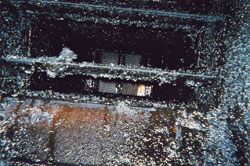Richard Norman (below), managing director, Indepth Hygiene Services and vice chairman of the HVCA’s Ventilation Ductwork Group, discusses the new legislation
on fire safety
IT seems appropriate that I should be writing about the new fire safety law, or, to give it its formal title, The Regulatory Reform (Fire Safety) Order 2005, in the Burning Issue column.
Besides loss of life, fire costs UK business millions of pounds each year from damage to property, loss of business, compensation claims and insurance premiums.
All this against a background where there are currently more than 100 pieces of legislation dealing with fire already on the statute book.
From October 1, much of the existing legislation will be replaced by the new fire safety law.
The new law has the teeth that are missing from current legislation. For example, there is currently confusion about who should be responsible for complying with the legislation. As a result, one of the existing requirements to produce a fire risk assessment has invariably gone by default. With the new legislation, however, there are serious penalties for compliance failure.
There will be a legally enforceable requirement for owners, or managers of premises, to appoint a “responsible person or persons” who will have the responsibility to prepare fire risk assessments and to ensure that action is taken to eliminate or, at the very least, minimise any identified risk to building occupants.
Failure to have carried out a fire risk assessment and to have addressed risks will result in criminal liability action against the “responsible person” in the event of a fire causing injury or death to building occupants.
In addition, the fire authorities, which will no longer issue fire certificates, will have the role of “policeman”.
They will have powers to demand sight of fire risk assessments.
While plenty of attention has been traditionally given by premises’ owners and maintenance managers to the installation of fire extinguishers, fire doors, fire escapes and the like, which are primarily intended to aid fire extinction and escape, there have been shortcomings in identifying all potential sources of fire dangers in buildings.

Greasy Ductwork: a real fire hazard but it is out of sight so it could be out of mind
For example, last year Indepth Hygiene’s surveyors visited 464 catering premises where, in nearly 80% of units, no thought had been given to the grease extract ducting behind the kitchen canopies as a potential fire risk area. Yet it is the extract ducting where grease particles created by the cooking operation accumulate to present a very real fire hazard.
The fact that much ventilation ducting is often concealed behind ceilings and walls is no excuse for not including ventilation ducting in the fire risk assessment, whether it be grease extract ducting or general extract and supply.
Even before the new regulations have become law, Indepth Hygiene, which carries out specialist deep cleaning of ventilation systems in accordance with HVCA TR19, has seen a considerable increase in requests for surveys and fire safety reports, which is a service it provides free of charge.
Apart from the importance of ensuring that legal obligations are fulfilled, there is the overlaying consideration of property insurance. In a recent conversation, a senior executive of the UK’s leading property insurer made his views quite clear.
“If there is a fire and it can be proved that the legislation has not been complied with, then claims for compensation would be put at risk”.
So between the rock of legislation and the hard place of property insurance there will be no place to hide for those responsible for buildings and their maintenance.